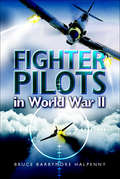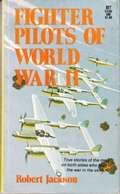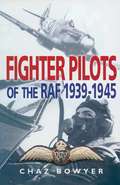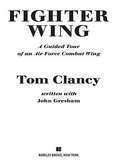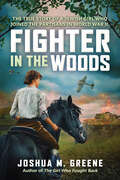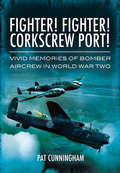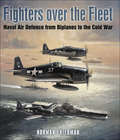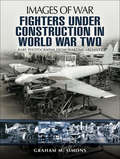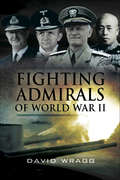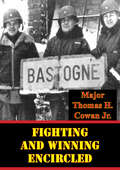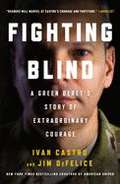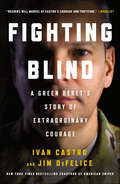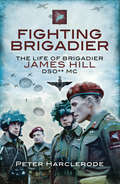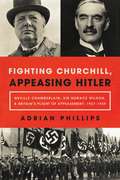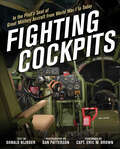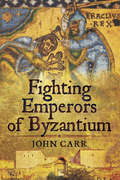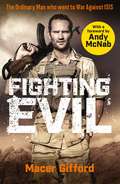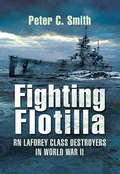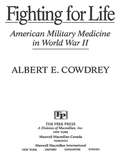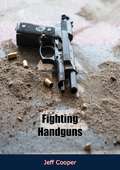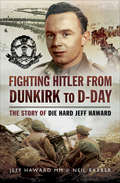- Table View
- List View
Fighter Pilots in World War II: True Stories of Frontline Air Combat
by Bruce Barrymore HalpennyThis is the story of Allied fighter pilots and the part they played in all the principal operational theatres of World War II. It also tells of life on the wartime airfield and how ground crew kept the aircraft ready for action either in the bitter cold of a Scottish winter or the sweltering heat of the North African desert. The book brings home the nervous strain caused by the constant readiness demanded by all those involved with fighter squadron combat and the intense comradeship created in each fighting unit.
Fighter Pilots of World War II
by Robert JacksonTo select fourteen fighter pilots from the hundreds who fought with distinction on all sides during World War II has been a difficult, not to say impertinent task. In the end, as representative of all the others, I selected those who, to my mind, showed certain individual characteristics that seemed to set them apart.
Fighter Pilots of the RAF, 1939–1945
by Chaz BowyerThe author has selected some twenty RAF fighter pilots of the Second World War, not only to give overdue recognition to their prowess and courage, but also to exemplify the wide diversity of the individual characters of those men whose war was fought from the cockpit of an RAF fighter. A few were familiar names but most received little or no public acclaim, being part of the silent majority which provided the real spine of the RAF's fighter effort throughout the conflict.
Fighter Wing: A Guided Tour of an Air Force Combat Wing (Tom Clancy's Military Referenc #3)
by Tom Clancy John GreshamNow, for the first time, an insider's look at an Air Force combat wing --the planes, the technology, and the people . . . with Tom Clancy as your guide. UPDATED WITH NEW MATERIALS AND PHOTOS!
Fighter in the Woods: The True Story of a Jewish Girl who Joined the Partisans in World War II
by Joshua M. GreeneFrom award-winning author Joshua M. Greene (The Girl Who Fought Back; Signs of Survival) comes this remarkable true story of a Jewish girl in Nazi-occupied Poland who escaped near death to join -- and fight -- with the Soviet partisans in the woods. Scholastic Focus is the premier home of thoroughly researched, beautifully written, and thoughtfully designed works of narrative nonfiction aimed at middle-grade and young adult readers. These books help readers learn about the world in which they live and develop their critical thinking skills so that they may become dynamic citizens who are able to analyze and understand our past, participate in essential discussions about our present, and work to grow and build our future.The year was 1941, and Nazi Germany was bombing Poland. Celia Kassow, a young Jewish girl, knew she was in danger of being seized by the Nazis, so she ran to seek shelter at a Polish classmate's house. The classmate's response? "Get away from here, you dirty Jew."Celia and her family, like all the Jewish families in their town, were then imprisoned in a Nazi ghetto, facing daily starvation and torture. Most of Celia's family was murdered there, but a different Polish classmate of Celia's, a boy who had a crush on her, helped Celia escape to his family's farm, and eventually, into the woods to join the Soviet partisans.The partisans were resistance fighters who gathered in secret during WWII to fight back against the Axis powers by attacking German garrisons and blowing up trains. When Celia joined them, the other partisans -- mostly young men -- wanted to put her on kitchen duty, but Celia refused and asked to be put on patrol. She was given a horse, ammunition, and an assignment. Celia survived the war fighting with the partisans. After the war, she would go on to get married, have children, and immigrate to the United States, where she lived out her days assisting other immigrants and raising her family. Her true story, based on first-person testimony and vetted by Celia's son, is one of incredible bravery and grit in the face of unimaginable evil.
Fighter! Fighter! Corkscrew Port!: Vivid Memories of Bomber Aircrew in World War Two
by Pat CunninghamThe young men who flew with RAF Bomber Command in World War Two were a complex mixture of individuals but they all shared the gift of teamwork. A crew of seven may have comprised all non-commissioned men and some crews included commissioned officers but not always flying as pilots. The outstanding fact was that each man relied on every other member of his crew to return from each mission safely.This book contains ten intriguing reminiscences of bomber aircrew; some were pilots, others navigators, flight engineers, bomb-aimers or gunners. They flew as both commissioned or NCO airmen. Understandably, a common problem was that of coping with fear. Many former aircrew hold that anyone who claims to have felt no fear on operations is either lying or has allowed the years to blank out that fear. But there are a few who do maintain that they never felt afraid. For the majority, though, handling fear was something to be worked out by the individual. Some hit the bottle, others womanized to excess; others tightened the gut and bit the lip; or drew the curtain and focused upon the plotting table or the wireless set. The passing years may have silvered what hair remains, dulled the eye that formerly registered on the merest speck; lent a quiver to the hand that once controlled the stick, penciled in the track, manipulated the tuning dial, set the bombsight, tapped the gauge, or rotated the turret. And yet for all the attributes of age their irrepressible youthfulness shines through.
Fighters Over the Fleet: Naval Air Defence from Biplanes to the Cold War
by Norman FriedmanA tactical and technical history of the development of British, American, and Japanese naval air defense from the 1920s to the 1980s. This is an account of the evolution of naval fighters for fleet air defense and the parallel evolution of the ships operating and controlling them, concentrating on the three main exponents of carrier warfare: the British Royal Navy, the U.S. Navy, and the Imperial Japanese Navy. It describes the earliest efforts from the 1920s, but it was not until radar allowed the direction of fighters that organized air defense became possible. Thus, major naval-air battles of the Second World War like Midway, the Pedestal convoy, the Philippine Sea, and Okinawa are portrayed as tests of the new technology. This was ultimately found wanting by the Kamikaze campaigns, leading to postwar moves towards computer control and new kinds of fighters. After 1945 the threats of nuclear weapons and standoff missiles compounded the difficulties of naval air defense. The second half of the book covers R.N. and U.S.N. attempts to solve these problems, looking at the American experience in Vietnam and British operations in the Falklands War. It concludes with the ultimate U.S. development of techniques and technology to fight the Outer Air Battle in the 1980s, which in turn point to the current state of carrier fighters and the supporting technology. Based largely on documentary sources, some previously unused, this book will appeal to both the naval and aviation communities.&“Fighters Over the Fleet provides more information about fleet air defense than any other work currently available. It is recommended for specialist as well aviation-minded readers.&” —Naval Historical Foundation
Fighters Under Construction in World War Two: Rare Photographs From Wartime Archives (Images of War)
by Graham M. SimonsThere has been bookshelf after bookshelf of books compiled, written and published about British aircraft, the Royal Air Force and the activities of its pilots during World War Two. Tales of derring do, bravery and gallantry quite rightly litter the bookshelves and libraries, but little has appeared in print about the could be called the unsung heroes, those that designed, built and maintained the fighting equipment used to eventually defeat the enemy.This is all the more incredible when one realizes that there exists a huge archive of images that have survived which clearly show the skills and scale of what went on. These images of war—many of which are seen here for almost the first time in seventy years—form a remarkable tribute to the designers, engineers and workers who did so much.Following the end of the Great War, the Royal Air Force was drastically reduced in both manpower and equipment. The application of a 'Ten Year Rule in which the British Government foresaw no war being fought during the next ten years resulted in minimal defense expenditure throughout the 1920s.Financial restrictions went on until the early 1930s, when it at last became apparent that Germany was developing expansionist and aggressive tendencies that could no longer be ignored. The British Government and Air Ministry at last began to develop plans of their own to expand and develop the Royal Air Force. The Cabinet approved a number of plans, but a revised one often replaced each one before the original could be completed.Between 1933 and 1939, the Royal Air Force was given higher priority in terms of rearmament plans than the other services. The policy was driven by the pursuit of parity with Germany more than by defense and strike needs, for there was no fixed ratio of bombers to fighter aircraft to guide procurement.There could be no expansion without manufacturing capacity and luckily these manufacturers were not only capable of producing, but they also recorded much of their activities and remarkably a huge archive of images have survived which clearly show the skills and scale of what went on. These images of war—many of which are seen here for almost the first time in seventy years—form a remarkable tribute to the designers, engineers and workers who did so much.
Fighters in the Shadows: A New History of the French Resistance
by Robert GildeaRobert Gildea's penetrating history of France during World War II sweeps aside the French Resistance of a thousand clichés. Gaining a true understanding of the Resistance means recognizing how its image has been carefully curated through a combination of French politics and pride, ever since jubilant crowds celebrated Paris's liberation in 1944.
Fighting Admirals of World War II
by David WraggSeapower was a crucial element in the outcome of the Second World War. The U-Boat campaign almost brought Britain to her knees; the Arctic convoys were crucial to keeping Russia in the War; Pearl Harbor brought America into the conflict with massive repercussions; allied naval supremacy made the D-Day landings possible.This book examines in detail the key naval commanders of both sides including five British (Pound, Cunningham, Ramsay, Horton, Somerville) and five US admirals (King, Nimitz, Spruance, Halsey, Fletcher), three German (Raeder, Doenitz, Lutjens) three Japanese (Yamamato, Nagumo, Koga) and two French (Darlan, de la Borde), the latterjustified by the problems faced by Vichy France, including the courageous decision to scuttle the fleet rather than let it fall into German hands in late 1942. In selecting the list, the author has made their decisive role in the war the only criterion.
Fighting And Winning Encircled
by Major Thomas H. Cowan Jr.This monograph answers the question "What must an encircled unit be provided and do in order to successfully hold?" Following the end of the Cold War and the subsequent drawdown, the United States adopted a military strategy of force projection. Given this new strategy, any future adversary of the United States is likely to attack early to deny the points of entry into the theater. The initial deploying U.S. forces must be prepared to fight and defend these points of entry until relieved or reinforced.The author uses historical examples of encirclements from World War II, Korea, and Vietnam to support lessons learned during a major simulation exercise in which a division had to fight encircled. The report presents the preconditions that an operational commander must set for the encircled unit which are: provide the necessary combat power, apply external pressure on the enemy, maintain air superiority, provide logistical support, and give the tactical commander freedom of action. Then the report takes a systems perspective to analyze the tactical commander's mission using the battlefield operating systems as a tool. The author presents the specific tasks the commander must execute and the concepts that he must consider. If the operational commander does not provide the necessary preconditions for success or the tactical commander does not take a systems perspective when setting up the defense, the encircled unit will fail.
Fighting Blind: A Green Beret's Story Of Extraordinary Courage
by Jim DeFelice Ivan Castro Ivan Castro and Jim DeFeliceFighting was a practiced routine for Lieutenant Ivan Castro. But when a mortar round struck the rooftop of his sniper’s post in Iraq, he found himself in a battle more difficult than even he could have imagined. The direct hit killed two other soldiers and nearly claimed Castro’s life as well. Mangled by shrapnel and badly burned, Castro was medevac’d to Germany more dead than alive. His lungs were collapsed. He couldn’t hear. One eye had been blown out, the nerve to the other severed. In the weeks and months that followed, Castro would find that physical darkness was nothing compared to the emotional darkness of loss and despair. Desperate for a reason to live, he eventually fought his way back to health through exercise and a single-minded goal: running a marathon. Once he set his course, there was no stopping him. Stubborn to a point that at times bordered on insanity, he managed not only to recover but to return to active duty. Since 2007, he has run over two dozen marathons, including the Boston Marathon in 2013, where he was one of the runners diverted when the bombs exploded. Today, Castro helps prepare soldiers for combat, working exactly as if he were “sighted.” Fighting Blind, this frankly told account of his struggle through adversity, the highs and lows and the always bumpy road in between, is a story of hope and perseverance against the odds: an Unbroken for the present generation.
Fighting Blind: A Green Beret's Story of Extraordinary Courage
by Jim DeFelice Ivan CastroFighting was a practiced routine for Lieutenant Ivan Castro. But when a mortar round struck the rooftop of his sniper’s post in Iraq, he found himself in a battle more difficult than even he could have imagined. The direct hit killed two other soldiers and nearly claimed Castro’s life as well. Mangled by shrapnel and badly burned, Castro was medevac’d to Germany more dead than alive. His lungs were collapsed. He couldn’t hear. One eye had been blown out, the nerve to the other severed.In the weeks and months that followed, Castro would find that physical darkness was nothing compared to the emotional darkness of loss and despair. Desperate for a reason to live, he eventually fought his way back to health through exercise and a single-minded goal: running a marathon. Once he set his course, there was no stopping him. Stubborn to a point that at times bordered on insanity, he managed not only to recover but to return to active duty. Since 2007, he has run over two dozen marathons, including the Boston Marathon in 2013, where he was one of the runners diverted when the bombs exploded.Today, Castro helps prepare soldiers for combat, working exactly as if he were “sighted.” Fighting Blind, this frankly told account of his struggle through adversity, the highs and lows and the always bumpy road in between, is a story of hope and perseverance against the odds: an Unbroken for the present generation.
Fighting Brigadier: The Life of Brigadier James Hill DSO** MC
by Peter HarclerodeIn the 1930s James Hill was forced to leave the Army because he was under 26 when he married. Recalled to the colors, he won his MC with the BEF in 1940. He was one of the first to volunteer for airborne forces and became second-in-command of 1 PARA. He was in the thick of the expansion of Airborne forces in 1941-42 and took command of 1 PARA in North Africa, winning his first DSO. He converted 10th Bn The Essex Regiment to 9 PARA and later in 1943 took command of 3 Parachute Brigade, playing a major role in the D-Day Landings. Wounded twice, his Brigade captured the key Merville Battery.The Brigade recovered to England in September 1944 before returning to Europe to contain the German winter Bulge offensive. In March 1945 his Brigade played a key role in the Rhine Crossing and raced east to block the Russian advance on Denmark.Post war Brigadier Hill was a leading figure in the Parachute Regiment and revered by fellow Paras. He died in 2006.
Fighting Churchill, Appeasing Hitler: Neville Chamberlain, Sir Horace Wilson, And Britain's Plight Of Appeasement: 1937-1939
by Adrian PhillipsA radically new view of the British policy of appeasement in the late 1930s, identifying the individuals responsible for a variety of miscalculations and moral surrender that made World War II inevitable. Appeasement failed in all its goals. The kindest thing that can be said of it is that postponed World War II by one year. Its real effect was to convince Hitler and Mussolini that Britain was weak and afraid of confrontation, encouraging them to ever-greater acts of aggression. The turning point of the Czech crisis in September 1938 came when Wilson saw Hitler on his own and left him convinced that Britain was bluffing and would not go to war to defend Czechoslovakia. The dismemberment of Czechoslovakia that followed was not the end of appeasement. The Anglo-German Declaration was Chamberlain’s personal vanity project but both Chamberlain and Wilson believed that it genuinely brought "peace for our time." Chamberlain and Wilson blindly pursued bilateral friendship between Britain and the dictators and ferociously resisted alternative policies such as working with France, the Soviet Union, or the U.S. to face down the dictators. They resisted all-out rearmament which would have put the economy on a war footing. These were all the policies advocated by Winston Churchill, the most dangerous opponent of appeasement. Churchill was a hated figure for Chamberlain and Wilson. They could not accept Churchill’s perception that that Hitler was the implacable enemy of peace and Britain, and opposing him became an end in itself for them. Churchill and Wilson had been bitter adversaries since early in their careers because of an incident that Fighting Churchill, Appeasing Hitler reveals publicly for the first time. Chamberlain had a fraught relationship with Churchill long before appeasement became an issue. Neither Chamberlain nor Wilson had any experience of day-to-day practical diplomacy. Both thought that the dictators would apply the same standards of rationality and clarity to the policies of Italy and Germany that applied in Britain. They could not grasp that Fascist demagogues operated in an entirely different way to democratic politicians. The catastrophe of the Chamberlain/Wilson appeasement policy offers a vital lesson in how blind conviction in one policy as the only alternative can be fatally damaging.
Fighting Cockpits: In the Pilot's Seat of Great Military Aircraft from World War I to Today
by Dan Patterson Donald NijboerWhat was it like to sit in the pilot's seat and take control of a P-51 Mustang in World War II? What about an F-14 Tomcat at the height of the Cold War? Or a Lockheed Martin F-22 Raptor today? The cockpits of these fighter and bomber aircraft are revealed in Fighting Cockpits. Showcasing more than 50 of the world's most famous combat cockpits from early World War I aircraft to present-day fighters, this book includes more than 200 rich color photos from photographer Dan Patterson, as well as detailed history about combat cockpit development from aviation expert and historian Donald Nijboer.Presented in large-format, you'll be blown away by studio shot spreads of views from the cockpits, vintage photographs of the aircrafts in action, and modern photography of surviving crafts. This book will complete any history buff or aviation enthusiast's library.Aircraft include:Wind in the Wires: Nieuport 28, Royal Aircraft Factory S.E.5, Bristol F.2, Fokker Dr.I, Sopwith Camel, Sopwith Triplane, AEG G.IV, SPAD VII, Halberstadt CL.IV, Fokker D.VIIThe Rise of the Monoplane: Martin MB-2, Hawker Hind, Fiat CR.32, Boeing P-26 Peashooter, Curtiss F9C, Sparrowhawk, Vought SB2U Vindicator, Westland Lysander, PZL P.11World War II: Supermarine Spitfire, Messerschmitt Bf 109, Republic P-47 Thunderbolt, North American P-51 Mustang, Handley Page Halifax, Vickers Wellington, Focke-Wulf Fw 190 Wurger, Fairey Firefly, Fiat CR.42, Ilyushin Il-2 Sturmovik, Heinkel He 219 Uhu, Kawasaki Ki-45 Toryu, Curtiss SB2C Helldiver, Northrop P-61 Black Widow, Boeing B-17 Flying Fortress, Boeing B-29 Superfortress, Dornier Do 335 Pfeil, Messerschmitt Me 262 Schwalbe, Arado Ar 234 BlitzCold War to the Present: North American F-86 Sabre, Boeing B-52 Stratofortress, Grumman A-6 Intruder, General Dynamics F-111 Aardvark, Hawker Siddeley Harrier, McDonnell Douglas/Boeing F-15 Eagle, Grumman F-14 Tomcat, Fairchild Republic A-10 Thunderbolt II, General Dynamics/Lockheed Martin F-16 Fighting Falcon, Mikoyan MiG-29, Rockwell B-1 Lancer, Lockheed Martin F-117 Nighthawk, Lockheed Martin F-22 Raptor, Lockheed Martin F-35 Lightning II Joint Strike Fighter
Fighting Emperors of Byzantium
by John CarThe Eastern Roman or 'Byzantine' Empire had to fight for survival throughout its long history so military ability was a prime requisite for a successful Emperor. John Carr concentrates on the personal and military histories of the more capable war fighters to occupy the imperial throne at Constantinople. They include men like it's founder Constantine I , Julian, Theodosius, Justinian, Heraclius, Leo I, Leo III, Basil I, Basil II (the Bulgar-slayer), Romanus IV Diogenes, Isaac Angelus, and Constantine XI. Byzantium's emperors, and the military establishment they created and maintained, can be credited with preserving Rome's cultural legacy and, from the seventh century, forming a bulwark of Christendom against aggressive Islamic expansion. For this the empire's military organization had to be of a high order, a continuation of Roman discipline and skill adapted to new methods of warfare. Thus was the Empire, under the leadership of its fighting emperors, able to endure for almost a thousand years after the fall of Rome.
Fighting Evil: The Ordinary Man who went to War Against ISIS
by Macer GiffordA visceral, riveting, no-holds-barred military memoir told from the front line of the war against ISIS with a foreword by Andy McNab. In the summer of 2014 the world watched in horror as the black flag of ISIS swept all before it. Mosul, the second largest city in Iraq fell, ISIS proclaimed the caliphate and the horror mounted: from the mass murder, rape and enslavement of the Yazidis to the public beheading of journalists by British jihadis. For Macer Gifford it wasn't enough to ask why more wasn't being done, he knew he had to act. So, he left his job in the city, split from his girlfriend and a few weeks later found himself illegally crossing the border into Syria to join the Kurdish YPG in their fight against the savagery of ISIS.Macer Gifford became one of longest serving British International Volunteers and one of the only few to be promoted to be a Commander in the YPG. He fought alongside the Kurds (and their Syrian Allies) for three long tours of duty from the dawn of the caliphate all the way to its military defeat in the ruins of Raqqa in 2017, sniping at the final deadly wave of suicide bombers as they burst from the rubble. Along the way, he made - and lost - many friends. This is the only complete account of the war against the Caliphate by the Kurds and the remarkable and often eccentric band of international volunteers who fought alongside them.
Fighting Evil: The Ordinary Man who went to War Against ISIS
by Macer GiffordA visceral, riveting, no-holds-barred military memoir told from the front line of the war against ISIS with a foreword by Andy McNab. In the summer of 2014 the world watched in horror as the black flag of ISIS swept all before it. Mosul, the second largest city in Iraq fell, ISIS proclaimed the caliphate and the horror mounted: from the mass murder, rape and enslavement of the Yazidis to the public beheading of journalists by British jihadis. For Macer Gifford it wasn't enough to ask why more wasn't being done, he knew he had to act. So, he left his job in the city, split from his girlfriend and a few weeks later found himself illegally crossing the border into Syria to join the Kurdish YPG in their fight against the savagery of ISIS.Macer Gifford became one of longest serving British International Volunteers and one of the only few to be promoted to be a Commander in the YPG. He fought alongside the Kurds (and their Syrian Allies) for three long tours of duty from the dawn of the caliphate all the way to its military defeat in the ruins of Raqqa in 2017, sniping at the final deadly wave of suicide bombers as they burst from the rubble. Along the way, he made - and lost - many friends. This is the only complete account of the war against the Caliphate by the Kurds and the remarkable and often eccentric band of international volunteers who fought alongside them.
Fighting Flotilla: RN Laforey Class Destroyers in World War II
by Peter C. SmithThe Laforays were the largest, most powerfully armed and successful ships of this type to see frontline action with the Royal Navy in WWII. They were also the handsomest warships to see service and presented a perfect combination of power and speed. They were assigned to the most dangerous theaters of war including Force H, sailing between Gibraltar and Malta, from where they operated against the German supply lines to North Africa. They escorted minelayers into the German backyard in the North Sea and their convoy escort work in the North Atlantic proved them to be highly effective hunter killers of the U-Boat packs that threatened every cargo ship carrying vital supplies to the UK. Such was the pace of their war, that out of the eight ships of the class only one survived the war.The book also includes chapters on their origin, planning and building, wartime operations and indices cover weapon systems, general fittings and complements and battle honors for each ship in the class.
Fighting For Life: American Military Medicine in World War II
by Albert E. CowdreyFought on almost every continent, the Second World War confronted American GIs with unprecedented threats to life and health posed by combat on Arctic ice floes and African deserts, steamy island jungles and remote mountain villages, the stratosphere and the depths of the sea. Service men were assaulted by frostbite, malaria, shrapnel, and landmines. But the demands of war provoked unparalleled medical advances in the years 1941-45, as well. In a war that unleashed the technology of destruction as no previous conflict had, the tale of those whose duty it was to save lives in World War II, not destroy them, has remained untold. Now, award-winning author Albert Cowdrey has written the first comprehensive history of one of the most important yet underappreciated weapons of World War II - America's extraordinary military medicine. Cowdrey tells the remarkable story of how American units developed and implemented new technology under dire pressures, succeeding so brilliantly that World War II became the first American war in which more men died in combat than of disease. Penicillin brought the antibiotic revolution to the battlefield, air evacuation plucked the wounded from jungles and deserts, and a unique system brought blood, still fresh from America, to our soldiers all over the world. Surgeons working just behind the front lines stabilized the worst cases, while physicians and public health experts suppressed epidemics and cured exotic diseases. Psychiatrists, nurses and medics all performed heroic feats amidst unspeakable conditions. Together, these men and women improvised medical miracles on the battlefield that could not have been imagined by practitioners in peacetime. Cowdrey recalls those triumphant years when Americans, blessed with the skill, courage, and dedication of a formidable medical fighting force, achieved a spectacular victory.
Fighting France: From Dunkerque to Belport (Hesperus Modern Voices)
by Edith Wharton Colm TóibínAs nuanced in her observations of human behavior as she is in her vivid depictions of French landscape and architecture, Wharton fully exploited her unique position as consort to Walter Barry, president of the American Chamber of Commerce in Paris, which allowed her unparalleled access to life in the trenches. Sensitive without sentimentality, and offering a valuable and extremely rare female perspective of a war dominated by the male viewpoint, this series of articles is nothing less than an inspirational testament to the strength of the human spirit at a time of the greatest adversity.
Fighting Handguns: History, Adventure And Romance Of Handguns From The Muzzle Loader To Modern Magnums
by Jeff CooperIn Fighting Handguns, author Jeff Cooper not only takes the reader through the development of this weapon from its beginnings in mid-16th-century Europe through the various iterations of single- and double-action revolvers and semiautomatic pistols, he also discusses some important aspects of carrying and shooting a fighting handgun under combat conditions.“For good or ill, man is a fighting animal. While most feel that this is an unmitigated evil, it may, like most aspects of nature, have its positive side. Certainly man’s combative nature is responsible for most of the massive tragedy of history, but it’s possible that history of any sort just wouldn’t have happened had it not been characteristic of the race to struggle against its environment. And man’s environment, of course, includes man. A placid, gentle, contented creature—a koala, for instance—is nice to contemplate but does not progress, and if it encounters a challenge it simply dies. Whether progress, at the price of a fighting disposition, is worth it is a question, but it’s a bit on the academic side. Man is the way he is, and gets along as he must. Being human, we are involved in strife. Much as we may deplore this, we must master the techniques of strife or perish.“This book is devoted to one of these techniques—the one-hand firearm as used by man against man.”—Jeff Cooper
Fighting Hitler from Dunkirk to D-Day: The Story of Die Hard Jeff Haward
by Jeff Haward Neil BarberFighting Hitler From Dunkirk to D-Day is the compelling story of a man belonging to a group of which there are now very few survivors. Jeff Haward MM is a pre-war Territorial Army soldier who enlisted merely for something to do in the evenings. Consequently, he fought throughout the entirety of the Second World War. Jeff is a 'Die Hard', the historic name given to men of the famous Middlesex Regiment. He joined the 1/7th Battalion, a machine-gun battalion, equipped with the British Army's iconic Vickers medium machine gun.Following evacuation from Dunkirk, the 1/7th, while refitting and re-equipping, carried out coastal defence duties in preparation for the German invasion. So desperate was the situation that on sentry duty, the one rifle per section had to be handed to the next sentry, along with the only ammunition available three rounds!In 1941, they were attached to the famous 51st Highland Division. The less than enthusiastic welcome from the Jocks gradually evolved into respect following the Middlesex's performance at El Alamein and the subsequent campaigns in North Africa, Sicily, Normandy and North West Europe.Following the Reichswald battle, in March 1945, Jeff was surprised to hear that he had been awarded the Military Medal for bravery and was subsequently awarded the ribbon by none other than Field Marshal Sir Bernard Montgomery.Jeff Haward's experiences, those of a normal soldier, make fascinating reading and throw new light on the use of such Vickers gun battalions during the war.
